![The Modern Dog Trainer Podcast – Ep. 4 The IAABC Shelter Program with Molly Sumridge]()
by Ines | Mar 12, 2016 | Podcast, Training Methods
In this podcast we invited Molly Sumridge, board member of the IAABC, to talk about their new shelter animal behavior program for shelter volunteers, staff, and trainers.
Subscribe to The Modern Dog Trainer Podcast on SoundCloud or iTunes. Follow The Modern Dog Trainer Blog on Twitter at @ModernTrainer, on Facebook at The Modern Dog Trainer Blog Page, and on Instagram at @TheModernDogTrainerBlog. We love hearing from our listeners! Please leave us a review on iTunes to help support our podcast!
Episode 4 – The IAABC Shelter Animal Behavior Program
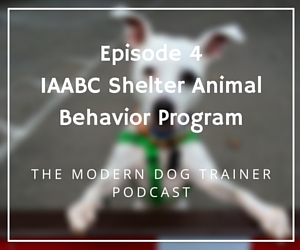 Molly Sumridge runs Kindred Companions in Frenchtown, NJ. We discussed all of the information available to members. Animal shelter volunteers can receive a discount. The IAABC library contains a tremendous amount of reading and handout materials in addition to access to world-renown animal behavior experts. We also discuss how Molly juggles the challenges and benefits of having a business that involves dog training, pet sitting, and a physical pet store.
Molly Sumridge runs Kindred Companions in Frenchtown, NJ. We discussed all of the information available to members. Animal shelter volunteers can receive a discount. The IAABC library contains a tremendous amount of reading and handout materials in addition to access to world-renown animal behavior experts. We also discuss how Molly juggles the challenges and benefits of having a business that involves dog training, pet sitting, and a physical pet store.
About the Hosts
Links mentioned in the show:
Dog Training Business Tips
Receive valuable dog training business tips and resources right in your inbox! Subscribe to The Modern Dog Trainer now by submitting your name and email below. Don’t forget to let us know what you want to learn more about!
[mc4wp_form]
![The Modern Dog Trainer Podcast – Ep. 4 The IAABC Shelter Program with Molly Sumridge]()
by Kat Camplin | Mar 11, 2016 | Training Methods
One of the first questions we ask behavior clients is if they’ve done a veterinary checkup. What meets this criteria is generally a physical examination, a CBC blood panel, and maybe a urine check if we’re dealing with “abnormal” urination. Is that enough? This is a story of my journey with my own dog’s sudden increase in aggression.
Aggression “Out of Nowhere”
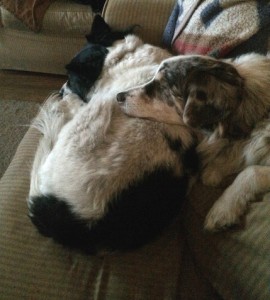
Paisley and Shira sharing space on the sofa.
This photo was taken a week before the aggression started. I put this here to show just how drastic the change in behavior was. Paisley is on the bottom. She’s a 7 year old white Border Collie mix. Shira is on the top. She’s a 12 1/2 year old Australian Shepherd. They’d lived together for 6 years, and while there have been scuffles over found food and competition while chasing cats, they lived mostly like this.
A week after this photo was taken Paisley violently attacked Shira while I was rearranging some furniture. I had put my training bag on the floor, and although there shouldn’t have been food in it, it was possible there was still a food smell. I put this first attack under the “found food,” resource guarding that I was familiar with. I chastised myself to be more careful and moved on with rearranging.
The second attack happened four days later with the addition of a new rug. Again, I thought this new rug had precipitated a new form of resource guarding and put the rug away until I had time to deal with the new addition.
Then the third attack happened. All the dogs were sleeping. Paisley woke up, began air scenting, began growling, looked for Shira, who was still asleep, then flew across the room and attacked her. Paisley has done a few more of these, waking from sleep, air scenting, growling, then searching for Shira. This video shows how it starts. Paisley respects the gates, but if they weren’t there she would have gone directly toward Shira who is sleeping behind the camera.
The Vet Check
After the third attack I purchased a few gates and took Paisley to the vet for a check up. She had an ear infection, so they cleaned her up, put a bunch of long lasting goop in the ear, and sent us home. The following day Paisley had numerous aggressive incidents. The gates were up, but she hit one of them pretty hard. I attributed this to the ear pain and began looking at adverse reactions to the ear medication. Nothing quite fit, so I decided to wait it out and see if her behavior got better as the ear got better.
Three days later there another violent outburst toward the gate. I decided we needed more information, so I made another vet appointment to do some blood tests. These tests came out almost perfect. She had an increase in pancreatic enzymes, but without any other symptoms the vets determined she did not have pancreatitis. She had dilute urine, which was unexplained. Coincidentally, there was another huge aggression event the day after the second vet visit. Stress was playing a role in the aggression.
Since she was attacking Shira, I decided to have Shira tested as well. She had the exact same results as Paisley, an increase in pancreatic enzymes and dilute urine. Again, with no other symptoms there was officially nothing wrong with her.
Getting Outside Help
I felt the need to get to work on a solution to stop the aggressive behavior. I called the amazing Sarah Owings to come help me work with some desensitization and counter conditioning with the gates as well as Paisley sharing space with Shira. The problem was there were times when Paisley was almost back to “normal.” Without a definitive trigger, we’d just be working toward a general co-existence between the dogs and they had had that before. Sarah recommended better gates so I could relax a bit more and a pre-consult with a Veterinary Behaviorist to see if that was a route I should take, meaning adding behavior medication to the mix.
In preparation for the behaviorist consult I asked for copies of the lab reports. While the veterinarian had told me the pancreatic enzymes were elevated, on the lab report they were incredibly elevated. I had Paisley tested again, but this time the results were normal. In 24 days the pancreatic enzymes had changed dramatically and I have no idea why.
Paisley did have a few minor symptoms. There were a few days when she initially refused her breakfast, although she eventually ate it. Within a two week period she had vomited twice. However, in all other respects she was perfectly healthy. She was eating, drinking, playing, and eliminating normally. The only change was her increased aggression episodes.
Taking A Break
I decided I really needed more information and didn’t quite know how to get it. My gut kept telling me this was a medical issue, but everyone kept telling me it was a behavioral problem. Telling my story got quite a few recommendations, everything from prong collars and alpha rolls to DS/CC to Prozac. One of the vets told me to rehome Paisley. The Veterinary Behaviorist didn’t see any aggression in the videos at all. It was a very frustrating time.
I began cataloging the conditions under which the aggressive episodes happened, not the aggressive behavior itself. I also began noticing other behavioral changes Paisley was displaying that were more subtle. For instance, the reason the video above was recorded was because Paisley had never taken a nap in that location before. Since that behavior was new, I decided to put up the camera in case there was an additional new behavior. Other new behaviors included an increase in growling as an attention seeking behavior, increased sound sensitivity, and resting in a number of unusual locations.
We had periods of time when everything seemed back to the time of pre-aggression, then something would happen. Some magic combination that I couldn’t quite pinpoint would create an aggressive episode. It seemed to have something to do with prey drive. The most consistent trigger was a cat passing the front porch when the door was open. I’m guessing frustration that she couldn’t get to the cat would cause Paisley to redirect toward Shira, but redirection is a new behavior for Paisley. There was something new in the mix, after all, we had 6 years of happy co-existence with the crazy cat lady living next door. There may be a pain component to the aggression. We do not know what happens biologically when a dog goes into prey drive. Does the stomach clench? Is there an increase in salivation or digestive acid in anticipation of food? There seemed to be something in there more than just redirected aggression, at least I thought so.
A New Vet. A New Dawn.
A month after the second blood check I decided to find a new vet who could help with more than just “she appears healthy.” I found Dr. Lisa Hsuan D.V.M through Sarah Owings and discovered what it’s like to work with a veterinarian who likes to play detective. We rechecked Paisley’s blood and checked her bile. Her blood was again “pristine,” however, her bile values were very high. We did an abdominal ultrasound, which showed abnormalities in the gall bladder, pancreas, stomach, and small intestines. Paisley was positive for pancreatitis, gastroenteritis, and liver malfunction. Is this what a sick dog looks like? This is 10 days before the last round of blood work and the ultrasound. The radiologist suggested we might test for Addison’s Disease in the next round of testing after we do the first round of medication and dietary changes. I’ll keep you updated on her progress.
We Should Never Punish Aggression.
I would hate to think where I would be if I had chosen to silence Paisley’s aggression through punishment. A lot of canine communication is so often considered “undesirable behavior,” and so it’s punished. I get it. When the dog’s behavior is causing fear in the human we want to quell it. In my case, my 13 year old dog was being attacked. It’s completely normal to try and quell that. However, we cannot condone silencing a dog who is trying to communicate. We see the outward behavior and we want to help clients, so we get working on a solution without really knowing what we’re dealing with. We can only change the behavior we see.
My own journey has made me reevaluate what really constitutes medical testing to rule out illnesses. At what point do we keep going with tests versus assuming the dog is healthy and work on behavior modification alone? With so little study behind medical causes of behavior change, sometimes we just have to go with our gut and hope we find something. We need to have this discussion. We need to share cases in which behavior change in the only symptom. We need to start listening to our dogs instead of trying to “fix,” them while we wait for more information.
The Tests.
For those of you interested in the medical tests, they are included in the links below.
Paisley Blood / Urine – Early Dec.
Paisley Pancreatitis – Late Dec.
Paisley Blood / Bile / Urine / Thyroid – Feb
Paisley Ultrasound – Feb
Paisley Pancreatitis – Feb
Shira’s Blood / Urine – Dec
Dog Training Business Tips
Receive valuable dog training business tips and resources right in your inbox! Subscribe to The Modern Dog Trainer now by submitting your name and email below. Don’t forget to let us know what you want to learn more about!
[mc4wp_form]
![The Modern Dog Trainer Podcast – Ep. 4 The IAABC Shelter Program with Molly Sumridge]()
by TMDT Team | Mar 5, 2016 | Events, Research, Training Methods
This post is written and provided by Lisa Gunter, MA. Lisa is a PhD student at Arizona State University in the Department of Psychology and conducts her research under the mentorship of Clive Wynne in the Canine Science Collaboratory. She has presented her research at numerous conferences including the Association of Professional Dog Trainers, the Interdisciplinary Forum for Applied Animal Behavior, the Veterinary Behavior Symposium and the International Society of Anthrozoology.

What Breed is That Doggy in the Shelter Window?
Chihuahua. Chow Chow. Pointer. Irish Wolfhound. When thinking about unique breeds and the range of physical differences that exist with man’s best friend, it’s hard to believe that a tiny toy lap dog and another that’s as tall as a human are of the same species [1].
For centuries, we’ve bred dogs for the purpose of aiding us in our work, such as in hunting (Labradors), herding (German Shepherd), and livestock protection (Great Pyrenees) [2]. Our influence on how dogs look and act brings along with it expectations about different dog breeds. When I say “Golden Retriever,” you likely think of a fluffy blonde dog that enjoys playing with children. When I mention a Border Collie, you probably imagine a wickedly smart black & white dog that plays fetch for hours.
In the United States, there are a little over 80 million dogs living with us with 20% of those dogs adopted from shelters [3]. As many of you have experienced firsthand, the way animal shelters operate today has changed from what homeless animals experienced just fifteen years ago. Before 2000, dogs usually stayed on average for about 10 days at the shelter. Then, over half were euthanized, and the others were either adopted or redeemed [4]. Today, the situation is better. While almost 4 million dogs are entering animal shelters each year, only 30% are euthanized [5]. While we’re pleased with these improvements, one of our main foci of research in the Canine Science Collaboratory at Arizona State University is to further increase adoptions and reduce euthanasia rates for pet dogs.
Given the importance placed on appearance in our culture, it should come as no surprise that looks matter in canine adoption, too! Researchers from the American Society for the Prevention of Cruelty to Animals (ASPCA) [6] found that appearance was the single most important reason people gave for why they adopted the dog they did. In our own lab we found that when potential adopters were presented with photographs of dogs that had been either adopted or euthanized they were able to distinguish which dogs had met which fate solely because the adopted dogs were more attractive than those that had ended up euthanized [7].
The Pit Bull Label
If you work in animal sheltering, you’ve likely heard of the term “pit bull.” While there is a specific breed of dog known as the American Pit Bull Terrier, more conventionally this label has been applied to many breeds that are short-haired, muscular and blocky-headed such as American and English bulldogs, Staffordshire bull terriers and American Staffordshire terriers as well as mixes of these types of dogs [8].
Recent studies into dog adoption [11, 7, 12-13] have found breed to be associated with different outcomes, including but not limited to increased euthanasia and length of stay. With the big role that physical appearance plays in dog selection, our lab was interested in understanding how breed labels could influence how attractive a dog seemed to be.
So what is the basis for the negative perceptions about pit bulls? The pit bull terrier does have a past that includes bullbaiting and dogfighting (which still occurs illegally in some areas of the US), and reports of aggression towards humans, specifically dog bite injuries and even deaths, have likely contributed to the unfavorable public opinion of these dogs as well [14-18]. Yet while an association may exist between certain types of dogs and aggression towards people, the reliability of breed characterizations in positively identifying dogs involved in these types of incidents is hotly debated [8, 19].
Labels vs. DNA Analysis

Photo by Erin Bessey
Which leads us to wonder what breeds of dogs are there shelters? It’s a more complicated question than it may appear, because breed assignment is usually based on the way the dog looks. Yet, researchers from Western University of Health Sciences [20-21] have found discrepancies between breed identification and the results of DNA analysis, and researchers in Florida found at one shelter that 50% of dogs that were labeled as belonging to a pit-bull-type breed lacked the DNA breed signature [22].
In our own lab, we’re wrapping up a multi-shelter study using the MARS Wisdom Panel. While it’s too early to talk about our specific findings, what we can say is that these shelter dogs show a range of breed diversity (over 150 breeds were identified at each shelter!), there are much fewer purebreds than we anticipated, most dogs have more than two breeds in their breed heritage and correctly identifying the breeds of a mixed breed dog via visual identification alone is an extremely difficult task.
Canine Science Symposium
Research questions like the ones I’ve mentioned here are just some of the questions we attempt to answer in the Canine Science Collboratory. If you enjoy learning about the latest research in canine science, you may want to consider attending our Canine Science Symposium. Now in its fourth year, the Symposium will be taking place at the San Francisco SPCA on April 16 & 17.
 While most of the speakers at the Canine Science Symposium are former or current students of Clive Wynne (the director of the Canine Science Collboratory), our research interests are diverse as evidenced by this year’s Symposium topics. Our presentations include decoding dominance in dogs; canine sociability and attachment; using advanced behavioral principles in dog training; applying cognitive, behavioral and physiological measures to improve shelter dog welfare; using play as training and enrichment; understanding visitor behavior in shelters to increase adoptions; exploring canine olfaction and interpreting canine body language. We want those that come out to learn with us to be able to walk away with new techniques and approaches to try in their interactions with shelter dogs, dogs that they train and the dogs they live with.
While most of the speakers at the Canine Science Symposium are former or current students of Clive Wynne (the director of the Canine Science Collboratory), our research interests are diverse as evidenced by this year’s Symposium topics. Our presentations include decoding dominance in dogs; canine sociability and attachment; using advanced behavioral principles in dog training; applying cognitive, behavioral and physiological measures to improve shelter dog welfare; using play as training and enrichment; understanding visitor behavior in shelters to increase adoptions; exploring canine olfaction and interpreting canine body language. We want those that come out to learn with us to be able to walk away with new techniques and approaches to try in their interactions with shelter dogs, dogs that they train and the dogs they live with.
For more information on the research studies I mentioned above, check out the journal articles references below. If you’re interested in attending the Canine Science Symposium, head on over to the SFSPCA website for all the details including speaker bios, presentation descriptions and online registration (at the bottom of the page). Our early-bird registration ends March 2nd, so those that want to attend should sign up now!
References
1. Coile DC. The dog breed bible. Hauppauge: Barron’s Educational Series; 2007.
2. Serpell J. The domestic dog. Cambridge: Cambridge University Press; 1995.
3. American Pet Products Association. U.S. pet-ownership estimates from the APPA for 2012. Available: http://www.humanesociety.org/issues/pet_overpopulation/facts/ pet_ownership_statistics.html#.U0oh8uZdW_A. Accessed 30 January 2014.
4. Wenstrup J, Dowidchuk A. Pet overpopulation: Data and measurement issues in shelters. J Appl Anim Welf Sci. 1999;2(4): 303-19.
5. American Society for the Prevention of Cruelty to Animals. FAQ, Pet statistics, 2012. Available: http://www.aspca.org/about-us/faq. Accessed 19 September 2014.
6. Weiss E, Miller K, Mohan-Gibbons H, Vela, C. Why did you choose this pet?: Adopters and pet selection preferences in five animal shelters in the United
States. Animals. 2012;2(2): 144-59.
7. Protopopova, A, Gilmour, AJ, Weiss, RH, Shen, JY, & Wynne, CDL. The effects of social training and other factors on adoption success of shelter dogs. J Appl Anim Welf Sci. 2012;142(1): 61-8.
8. Lockwood, R, Rindy, K. Are “pit bulls” different? An analysis of the pit bull terrier controversy. Anthrozoos. 1997;1: 2-8.
9. Posage, JM, Bartlett, PC, Thomas, DK. Determining factors for successful adoption of dogs from an animal shelter. J Am Vet Med Assoc. 1996;213(4): 478-82.
10. Lepper, M, Kass, PH, Hart, LA. Prediction of adoption versus euthanasia among dogs and cats in a California animal shelter. J Appl Anim Welf Sci. 2002;5(1): 29-42.
11. Brown, WP, Davidson, JP, Zuefle, ME. Effects of phenotypic characteristics on the length of stay of dogs at two no kill animal shelters. J Appl Anim Welf Sci. 2013;16(1): 2-18.
12. DeLeeuw, JL. Animal shelter dogs: Factors predicting adoption versus euthanasia. Doctoral dissertation, Wichita State University. 2010. Available: http://soar.wichita. edu/bitstream/handle/10057/3647/d10022_DeLeeuw.pdf?
sequence=1
13. Clevenger, J, Kass, PH. Determinants of adoption and euthanasia of shelter dogs spayed or neutered in the University of California veterinary student surgery program compared to other shelter dogs. J Vet Med Educ. 2003;30(4): 372-378.
14. Sacks, JJ, Sattin, RW, Bonzo, SE. Dog bite-related fatalities from 1979 through 1988. J Am Vet Med Assoc. 1989;262(11): 1489-1492.
15. Sacks, JJ, Lockwood, R, Hornreicht, J, Sattin, RW. Fatal dog attacks, 1989-1994. Pediatrics. 1996;97(6): 891-895.
16. Sacks, JJ, Sinclair, L, Gilchrist, J, Golab, GC, Lockwood, R. Breeds of dogs involved in fatal human attacks in the United States between 1979 and 1998. J Am Vet Med Assoc. 2000;217(6): 836-840.
17. Kaye, AE, Belz, JM, Kirschner, RE. Pediatric dog bite injuries: A 5 year review of the experience at the Children’s Hospital of Philadelphia. Plast Reconstr Surg. 2009;124(2): 551-558.
18. O’Brien, DC, Andre, TB, Robinson, AD, Squires, LD, Tollefson, TT. Dog bites of the head and neck: an evaluation of a common pediatric trauma and associated treatment. Am J Otolaryngol. 2015;36(1): 32-38.
19. Patronek, GJ, Sacks, JJ, Delise, KM, Cleary, DV, Marder, AR. Co-occurrence of potentially preventable factors in 256 dog bite–related fatalities in The United States (2000-2009). J Am Vet Med Assoc. 2013;243(12): 1726-1736.
20. Voith, V, Ingram, E, Mitsouras, K, Irizarry, K. Comparison of adoption agency breed identification and DNA breed identification of dogs. J Appl Anim Welf Sci. 2009;12(3): 253-262.
21. Voith, VL, Trevejo, R, Dowling-Guyer, S, Chadik, C, Marder, A, Johnson, V et al. Comparison of visual and DNA breed identification of dogs and inter-observer reliability. Am J Sociol Res, 2013;3(2): 1729.
22. Olson, KR, Levy, JK, Norby, B, Crandall, MM, Broadhurst, JE, Jacks, S et al. Inconsistent identification of pit bull-type dogs by shelter staff. Vet J , 2015.
23. Patronek, GJ, Glickman, LT, Moyer, MR. Population dynamics and the risk of euthanasia for dogs in an animal shelter. Anthrozoos. 1995;8(1): 31-43.
24. Salman, MD, New, Jr, JG, Scarlett, JM, Kass, PH, Ruch-Gallie, R, Hetts, S. Human and animal factors related to relinquishment of dogs and cats in 12 selected animal shelters in the United States. J Appl Anim Welf Sci. 1998;1(3): 207-226.
![The Modern Dog Trainer Podcast – Ep. 4 The IAABC Shelter Program with Molly Sumridge]()
by Thomas Aaron | Feb 20, 2016 | Business, Training Methods
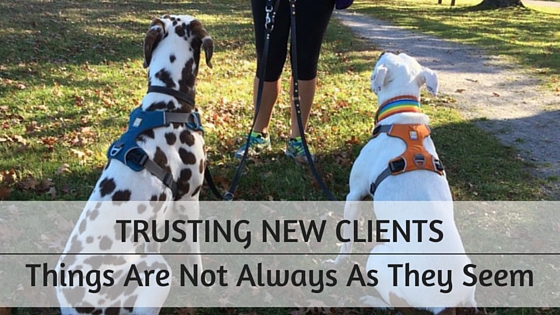
It is a story often told among dog trainers. It goes something like this:
A prospective client calls and says that another dog trainer – sometimes multiple dog trainers – could not help their dog or said their dog was beyond help. We take the case and find that the dog is indeed help-able. In fact, we do wonders with the dog in a short period of time, and we are perplexed and discouraged that the other trainer (or trainers) almost destroyed the client’s hope for their pet, when in fact the case really was not that difficult.
Recommended Reading: The Importance of Asking the Right Questions to New Dog Training Clients
When we take such cases and succeed in helping a dog, there is a part of us that feels superior – that other trainers in our area are not as capable as we are. Frankly, it feels kind of good, and we can’t wait to herald the news to our other colleagues so that they can be wary of the incompetent, unhelpful trainers who nearly destroyed some pup’s life.
All is well that ends well, right? The dog received the help it needed. The client is happy. We feel more confident than ever. But there often is another side to such stories.
Taking Client’s Comments With A Grain Of Salt
Perhaps the client was indeed telling the truth about the other trainer(s). But stories about multiple trainers failing cause me to be suspicious of the client – especially if my impression is that the dog’s problems are easily remedied.
We need to consider that clients may not always be truthful. They are human (like us), and sometimes they are not above behaving in a way that gets them what they want or makes them feel good (like their dogs).
A case in point: I recently was approached by a prospective client who told me that one of my most trusted colleagues and referral partners had recommended my board-and-train program. According to this client, my colleague thought it would be a better option for this particular dog than her own group class.
When I called my colleague to thank her, I learned the prospective client was lying. In fact, my colleague had this client on the roster for an upcoming, limited-size group class and had no idea the client was still shopping around for trainers.
When questioned about the situation, the prospective client began back-pedaling and telling me more lies to extricate herself from the first one. I decided not to accept this person as a client. If she was willing to blatantly lie to me (she could have just said they would rather do a board-and-train program), then what would she have been capable of unjustly saying about ME? It just didn’t seem worth the risk.
Digging For The Truth
As a rule, when a potential client tells me they have worked with one or more trainers, I require them to tell me who the trainers were, what steps were taken to solve a dog’s behavior issues, and how the dog responded to those steps. (And if I personally know one or more of the trainers mentioned, I might call them to better understand their experience with the client and dog.) If the prospective client is not willing to be forthcoming with such information – or if the information they provide throws up red flags about their own credibility or willingness to follow through with a trainer’s advice – I am better off without them.
Give Colleagues The Benefit Of The Doubt
Professionally speaking, I think it is a bad idea to give credence to unverified testimony against colleagues. Doing so risks us forming (or worse, spreading) false conclusions about them, and it potentially burdens us with deceitful or non-compliant clients. There are two sides to every story, and if we are to make a judgement about the credibility of a prospective client or the professionalism of a colleague, it is only right to get all the pertinent details and understand both sides of the story.
My mission as a professional dog trainer is helping dogs, but sometimes owners need help too. And sometimes helping an owner is showing them that some behaviors are rewarding, whereas others are not.
Have you ever had a similar experience?
Dog Training Business Tips
Receive valuable dog training business tips and resources right in your inbox! Subscribe to The Modern Dog Trainer now by submitting your name and email below. Don’t forget to let us know what you want to learn more about!
by Monica Callahan | Jan 19, 2016 | Training Methods
CleverPet: Challenge Your Dog Like Never Before
Have you heard of CleverPet yet? At the beginning of the year at the CES conference, a brand new dog puzzle toy was announced. Essentially, this is a new game console made specifically for your dogs.
How does CleverPet work?
CleverPet can hold and dispense any type of dry dog food. There are three buttons on the console’s body, and it begins by dispensing a treat for free to get the dog acclimated to the console. Then, the game gets a little harder once your dog catches on. This game console adapts to what your dog needs while playing and can even get your dog to press lighted sequences before dispensing a treat. CleverPet is being pitched as the best puzzle toy on the market for dogs as it constantly challenges our dogs in different ways. In fact, new games can continually be added to the CleverPet hub via your home’s WiFi signal.
Leo Trottier is one of the co-founders and holds a PhD in cognitive science from the University of California, San Diego. He claims that this toy is a great alternative to doggy day care or a great toy for families who are afraid their dogs are getting bored at home. He says that CleverPet is a great way to dole out food to your dog throughout the day and that you can keep tabs on your dog’s activities during the day while you are gone through their mobile app.
https://youtu.be/fMQ6WuTcsLE
Why Should Dog Trainers Care?
- Separation Anxiety: This is an obvious game changer, but imagine the entertainment it can provide for our client’s dogs who live with separation anxiety. The fact that it changes games will keep their dogs entertained longer than a Kong or other fillable toy would.
- Family Life: Are your clients bringing home a baby soon, or are they looking for ways to entertain their dogs while they deal with the life of children? This is a great way to engage their dog’s minds so parents don’t feel guilty not giving their dog as much attention as they are used to having.
- Confidence: Do your client’s dogs have low self esteem or confidence issues? Starting off easy and slowly getting harder will help build the confidence in dogs who need help.
CleverPet can currently be pre-ordered on their website for $299. To find out more information and watch this console in action, visit their website.
Dog Training Business Tips
Receive valuable dog training business tips and resources right in your inbox! Subscribe to The Modern Dog Trainer now by submitting your name and email below. Don’t forget to let us know what you want to learn more about!
[mc4wp_form]
![The Modern Dog Trainer Podcast – Ep. 4 The IAABC Shelter Program with Molly Sumridge]()
by Erin Bessey | Jan 18, 2016 | Business, Training Methods
Welcome 2016! Traditionally people begin thinking of their New Year’s Resolutions shortly after the start of the new year, maybe a week or two before. While there are the common, personal New Year’s Resolutions – eat healthy, exercise more – what about your resolutions as a dog trainer? What have you resolved to do? How are you going to better yourself and your business this year? We are already half way through January and if you haven’t come up with any resolutions we’ve got you covered.
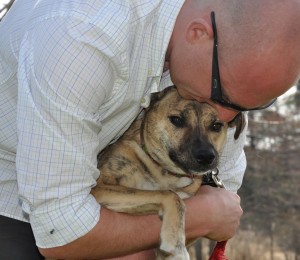
Image via Erin Bessey – Bessey’s Positive Paws
10 New Year’s Resolutions
Increase Clientele
Review your clientele numbers for the last year or two. Then figure out how much you would like to grow this year and set a goal to increase those numbers for 2016.
Network More
Maybe you are just starting out in your business, perhaps you are well established, whichever you are make a point to reach out to others. We can fall into patterns easily and get comfortable there. You won’t be able to grow if you don’t push those comfort levels. Reach out to other trainers, veterinarians, groomers, boarding and daycare facilities. Those are the traditional places to network. What about thinking outside the box? Look to speaking with schools or children’s daycare. While this may seem odd, these places have great, continuous interactions with families. Families who like to share stories about their kids and the family pet. Maybe the daycare is run in a home and has a dog that is present. Putting your name out there and talking to some office people is all it would take. Your name could spread like wildfire because who else would think to make themselves known at a non dog-related business?
Earn Certifications
This is the year to get certified or get more memberships! Sign up for the test (if required) to commit yourself to becoming certified and then start studying. There’s no better way to set yourself apart from others than to have obtained a few certifications. Certification of Professional Dog Trainers, Karen Pryor Academy, International Association of Behavior Consultants are just a few to look into.
Raise The Rates
If it has been a number of years and you are still maintaining the initial starting rate it might be time to increase. The business is growing and it is important to stay competitive with the surrounding areas while being paid your worth.
Train Your Own Dog
As a trainer we get very fixated on our work. Why wouldn’t we? We love what we do, but because we are busy helping others train their dogs our personal pets often fall to the way side. Make one of your new year’s resolutions to teach your dog a new trick or activity.
Teach A New Class
If you haven’t given your classes a face lift in a while make it happen this year. Have you just updated the current class curriculum? Why not look into offering a new class.
Learn A New Skill
The dog training world is exploding with all kinds of training. If you are used to teaching basic behavior classes take the time, reach outside of your comfort zone and learn something new. If you have never done agility, find a class and try it out with your own dog or better yet, build your own equipment. Interested in doing a trick class? Teach your dog the trick first before offering it to others. You would accomplish two resolutions on your list doing it this way! Try any one of the following: Treiball, heel work, Rally-o, agility, dog sports, trick training, nose work, and the list goes on!
Read More Books
In order to learn a new skill it may require you to read a new book to accomplish that. Challenge yourself and read a book that you don’t necessarily agree with as far as training techniques. Exercise your mind and form opinions and arguments and be sure to be able to back up your position. How many dog training books did you read last year? Can you do better?
Set A Schedule
It can be tough setting a schedule and sticking to it. Dog trainers want to help owners and their dogs as much as they can and go to great lengths to do this. Making time when we wouldn’t otherwise be scheduling due to fear of losing a potential client isn’t always best. Being too flexible could indicate to clients business is slow. Avoid answering e-mails and phone calls at all hours. Instead have a shut off time where you are done work for the day. Set a schedule if you don’t have one and stick to it.
Make Time To Play
Make time for yourself! To avoid burn out you need to be sure to leave time for yourself to play. This is where setting a schedule as one of the new year’s resolutions will be helpful. Play might be considered learning a new skill or working with your own dog but be sure to leave time to do something for you. It’s okay to do that!
What new year’s resolutions have you made? Comment below and let us know.
Sign up below to stay up to date with modern dog training business practices and dog training methods!
Dog Training Business Tips
Receive valuable dog training business tips and resources right in your inbox! Subscribe to The Modern Dog Trainer now by submitting your name and email below. Don’t forget to let us know what you want to learn more about!
[mc4wp_form]
![The Modern Dog Trainer Podcast – Ep. 4 The IAABC Shelter Program with Molly Sumridge]()
by Laurie Schlossnagle | Jan 12, 2016 | Business, Training Methods
What Is Continuing Education?
In a quick, unscientific poll of a small number of colleagues and clients, the overwhelming results were that clients appreciate knowing their trainers are participating in hands-on continuing education. To be among the best of the best in the dog training field, it is important to also be a student. Some certifications for dog trainers require continuing education to maintain certification; some dog trainers choose to participate in continuing education.

Continuing education can take on many forms. It can be a book that is read, a dvd that is watched, a seminar that is observed, a local workshop that is hands-on, a national conference that is all of the above with the added bonus of networking with colleagues. While a list of books read and dvds watched can be impressive, spending time and funds on a seminar, workshop, and/or conference shows clients a different level of commitment to continuing education – a level of investment both of time and funds to seek out knowledge and information.
Recommended Reading: Top 10 Dog Training Conferences for 2017
Why Is Continuing Education Important For Dog Trainers?
Accountability – seeking out and participating in continuing education puts a trainer into the position of being a student and demonstrating results.
Commitment – commitment to our profession, commitment to our clients, commitment to our dogs. Attending workshops, seminars, classes, etc. sparks a renewed commitment to spend time doing what we love.
Maintenance of/increasing knowledge and skill – use it or lose it! Teaching helps us to maintain our knowledge and skill but continuing education helps us to increase that knowledge and skill. Learning about new thought processes and methods expands our range of who we can help and how we can help them.
Staying on the cutting edge – there is constantly new science about dogs, about learning, about humans, about the dog/human interaction, etc. Participating in continuing education keeps trainers up to date on the latest and greatest science and how it can be useful in dog training.
Related: Check out our “Mastermind Meetups for Modern Dog Trainers” and request one in your area!
Sign up below to stay up to date with modern dog training business practices and dog training methods!
Dog Training Business Tips
Receive valuable dog training business tips and resources right in your inbox! Subscribe to The Modern Dog Trainer now by submitting your name and email below. Don’t forget to let us know what you want to learn more about!
[mc4wp_form]
![The Modern Dog Trainer Podcast – Ep. 4 The IAABC Shelter Program with Molly Sumridge]()
by Ines | Jan 5, 2016 | Training Methods
I don’t believe that there is such a thing as a perfect reactive dog class. Humans will be humans, dogs will be dogs, and real life training means unexpected situations will arise. However, there are some expected situations we can prepare for to ensure success and progress with our reactive dog clients.
Management Solutions for Teaching a Reactive Dog Class in Imperfect Locations
Not all of us have an ideal environment to host group classes for reactive dogs. The dream is to have a large covered outdoor area that is fenced in to keep loose dogs and curious owners at a distance. This is not the reality for most group classes. However, the demand for classes or semi-private lessons for reactive dogs is high so sometimes you it makes the most sense to provide your clients with an affordable group class.
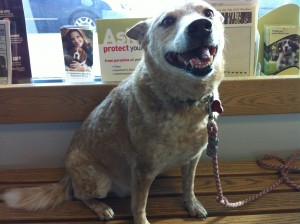
I have taught classes outside in fields and in small, echoey rooms, but neither is really ideal for reactive dogs due to the chance of off leash dogs coming up in one case and being in close proximity to other dogs in class in the other. Fortunately, all of the dogs in both of these situations can make progress thanks to creative management solutions you can put in place.
As a trainer, your first step is to break down the triggers a dog typically reacts to (in this case other dogs) enough so that when the reactive dog is exposed to it, they don’t have a reaction. In reality, all group classes will set the dogs up to get excited and aroused at first.
Most reactive dogs will get anxious and aroused at the mere thought, smell, or sound of another dog. This means that they don’t actually have to see each other to start the counter conditioning process. Visual barriers are a necessity for every group class with reactive dogs. The dogs will be able to smell and hear, but not see each other. This will reduce their arousal, increase their focus, and allow you to begin the counter conditioning process.
Barriers can be made out of all kinds of materials. You can use PVC pipes to make a frame and then hang fabric from the frame. I have used and recommend getting large panels of insulation and duct taping them together so they can make an L shape and stand alone. The insulation is strong enough to stand by itself and helps reduce noise, but should be stored in a location where dogs cannot get to it and eat it. If you have a larger budget, you can consider making panels out of solid corrugated plastic.
Entering and Leaving Reactive Dog Class
This can sometimes be the most challenging part of reactive dog classes. Everyone has to come through the same doorway to enter and exit the room. There are two approaches you can use to avoid this potentially dangerous situation.
The first is to ask clients to keep their dogs in their cars until you come out and ask them to come in. Most dogs feel safe in their cars. For added precautions, remind your clients to keep their dogs in a covered crate in their cars so the dog does not look out the window and bark at other dogs going by before class. Reactive incidences before class could stunt a dog’s progress during class.
Another idea I got from fellow professional dog trainer, Sarah Fulcher, CDBC, KPA-CTP, is to stagger your group class arrival and departure times for each dog so that no one enters or exits at the same time. Sarah says, “I found that when I had the dogs enter and exit the class room [at set intervals] really helped to keep the classes calm. It also became a valuable exercise for each dog in class – the first dogs in the room had the challenge of staying settled when they could hear or see another dog entering (depending on their progress level, they may or may not have had a visual barrier set up). The dogs that left first had the challenge of possibly walking past another dog, and those staying had to work on being calm while they could hear or see another dog enter or exit. I was always careful to set the dogs up for success, knowing what their triggers and thresholds were, and setting up the entry and exit portions of class so that each dog would be challenged just enough.”
Set Strict Rules for Your Clients
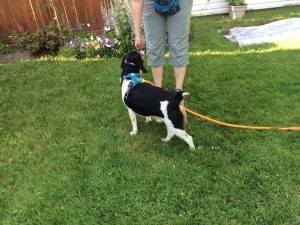
During group classes, don’t be afraid to give your clients strict instructions to ensure their dogs are not set up to fail outside of class. Instead, give them a list of alternative methods to wear their dogs out without having to expose their dogs to triggers. I always recommend that clients avoid dog parks, busy neighborhoods, remind them to block off windows, and other situations that could trigger their dogs to react. Your clients will be overwhelmed with information so break instructions down and make them as specific as possible to set them up for success.
What Your Reactive Dog Clients Do Outside of Class Matters More Than What They Do During It
Sometimes you might be so focused on setting the dog up to be successful that you might forget to set the owner up to be successful, too. As clients become more aware of their dog’s needs, they may take to doing some research for themselves. They may seek out guides, resources, and videos online to learn from. If you have a client like this, consider yourself lucky. They’re demonstrating their commitment to working with their dog, but it can also leave you in a sticky situation.
We all know the internet holds a wealth of knowledge when it comes to dogs. Unfortunately, a lot of the information that is readily available is incorrect, outdated, or untrue to the real science behind dog training. The success of a reactive dog team relies on making sure they stick to your proven plan that revolves around desensitization, counter conditioning, classical conditioning, and some foundation obedience cues. The last thing you want is for the owner to start trying new things they saw online. So what do you do?
You can recommend books, blogs, or Youtube video channels that follow your training approach, but some times that can confuse your client’s even more with terminology or exercises that aren’t part of your program. Ideally, you’d have one place online to send them to so that they could review the exercises you teach in class with more explanations, videos, and graphics to further demonstrate your class’s material.
What is the most challenging thing you find about teaching reactive dog training classes? Comment below!
Sign up below to stay up to date with modern dog training business practices and dog training methods!
Dog Training Business Tips
Receive valuable dog training business tips and resources right in your inbox! Subscribe to The Modern Dog Trainer now by submitting your name and email below. Don’t forget to let us know what you want to learn more about!
[mc4wp_form]
by Kat Camplin | Jan 4, 2016 | Events, Training Methods
The Ultimate Animal Training Conference Wish List for 2016
Education, networking, adventure, and fun! Here are the best training and education conferences for you to attend in 2016. It was particularly difficult to whittle down the list this year. If your conference didn’t make the cut please post registration information in the comments! Conferences are listed in chronological order due to the author’s inability to decide which should be first.
ClickerExpo
ClickerExpo will be held in 3 locations throughout 2016. This year ClickerExpos have slightly different labs and workshops depending on the location.
Reno, Nevada
When: Friday, January 22-24, 2016
Where: Reno, Nevada
Why: New for 2016 are Educational Themes. Themes include: Trainer Skill Development, Teaching People, Aggression and General Behavior Management. Feel free to follow a single theme or skip around. There’s something for everyone! CCPDT, IAABC, and KPA Continuing Education Units are available for professionals attending this event.
More Information: http://www.clickertraining.com/clickerexpo/registration-NV-2016
Cincinnati, Ohio
When: Friday, March 18-20, 2016
Where: Cincinnati, Ohio
Why: New for 2016 is a complete Equine Theme which includes Husbandry, Saddling, Trailer Loading, and much more! This is in addition to the Themes listed for Reno above. CCPDT, IAABC, and KPA Continuing Education Units are available for professionals attending this event.
More Information: http://www.clickertraining.com/clickerexpo/registration-OH-2016
ClickerExpo Europe
When: Friday, October 28-30, 2016
Where: Billund, Denmark
Why: The ClickerExpo 2016 schedule for Denmark has not been released yet. It will be released by 15 February 2016. The highlight so far? The conference is going to be held in the LegoLand Hotel!
More Information: http://www.clickertraining.com/clickerexpo/denmark/register
ORCA 8th Annual Art and Science of Animal Training
When: Saturday, February 20-21, 2016
Where: Dallas, Texas
Why: ORCA is now a two day event! This conference has become a staple for all animal trainers. Bringing together trainers and behavior analysts, the conference covers a broad spectrum of knowledge of animal behavior and how to get it. This year has two themes. Saturday will cover shaping behavior in both animal and human learners, and Sunday will cover concepts and tools for improving animal welfare and human-animal interactions. This year’s keynote speaker, Dr. Iver Iversen, will discuss: “Selection and creation processes involved in shaping of novel behavior: Method and Theory.”
More Information: http://www.artandscienceofanimaltraining.org/conference/
Penn Vet Working Dog Conference
When: Friday, April 8-11, 2016
Where: Philadelphia, Pennsylvania
Why: You may have seen this conference’s DVD’s on TawzerDog. Did you know you could attend the Penn Vet Working Dog Conference? This year’s theme is “Whole Dog 360: A multidisciplinary approach.” Individual topics will be addressed with a series of four (4) – ½ day sessions: Advancements in working dog health and medicine; Training the working dog using current scientifically-based methods; Implications of handler training on the successful working dog team; Driving progress in the working dog field through research & innovation. This year’s keynote speaker will be Ken Ramirez.
More Information: http://pennvetwdc.org/education/conference/
IAABC Animal Behavior Conference
When: Saturday, April 9-10, 2016
Where: Anaheim, California
Why: The International Association of Animal Behavior Consultants has creatively merged their Feline and Canine Conferences into one event. Choose to follow the Feline or Canine track, or pick and choose which presentations you’d like to join. The dual-track conference features speakers discussing the latest science, treatments, and protocols for managing and modifying behavior in dogs and cats.
More Information: https://iaabc.org/conference/2016
Animal Management Behavior Alliance (ABMA) Annual Conference
When: Monday, April 17-22, 2016
Where: Tampa, Florida
Why: The Animal Behavior Management Alliance (ABMA) specializes in animal care and training through enrichment. This year’s theme is “Breaking Down Barriers: New Possibilities in Animal Welfare.” Conference locations include multiple zoos and a post conference trip to Natural Encounters. This year’s keynote speaker will be Dr. Susie Ellis of the International Rhino Foundation. Details will be posted as they are finalized.
More Information: https://theabma.org/abma-annual-conference/
DogEvent 2016
When: Thursday, May 5-8, 2016
Where: Nice, France
Why: You’ve always wanted to see Nice and now you have an excuse! 4 days of dog training, behavior workshops, and demos. Each day has a theme: Shelter Dogs, Behavior Analysis, Training, Canine Nutrition, and Advanced Behavior Techniques. Speakers include Dr. Clive Wynne, Ken McCort, Jean Lessard, Nancy Tucker, and Dr. Jean Dodds. This conference has a limit of 100 attendees.
More Information: http://www.dogconseil.com/dogevent2016/en/
Fenzi Dog Sports Academy Training Camp
When: Friday, June 19-22, 2016
Where: Purina Farms – Gray Summit, MO
Why: It’s bigger. It’s better. It’s at Purina Farms! The Ultimate Dog Sports Training Camp covers Obedience, Rally, Agility, Nosework, Freestyle, and Rally FrEe! Join the dynamic dog sports goddesses Denise Fenzi, Deb Jones, Hannah Branigan, Julie Flanery, Loretta Mueller, Nancy Gagliardi Little, Shade Whitesel, Sue Ailsby, Amy Cook, Julie Symons, and Stacy Barnett for 4 days of fun. Work on heeling, scenting, retrieves, utilizing play to build motivation, and so much more.
More Information: http://www.fenzidogsportsacademy.com/index.php/waiver-of-liability/8-fdsa/6934-fdsa-camp-2016
Canine Science Forum
When: Tuesday, June 28-July 1, 2016
Where: Padova, Italy
Why: The CSF is a biannual event. This year’s topics include: Evolution of canines; Ecology and conservation of canines; Dogs and humans; Applied aspects of canine biology; Behavioural biology of canines; Cognition; Canine genetics and endo/phenotyping. The Forum also includes a Round Table on service dogs that will introduce some of the main issues related to service dogs and defining the needs and critical points of this area.
More Information: http://www.csf2016.com/index.php
APDT Annual Conference and Trade Show
When: Wednesday, October 12-15, 2016
Where: Las Vegas, Nevada
Why: You’re a professional dog trainer, this is your Association. The Association of Professional Dog Trainers Annual Conference is full of prestigious speakers and engaging seminars. The speakers and schedule for 2016 is still pending. This entry will be updated as information becomes available.
More Information: https://apdt.com/conference/
Pet Professional Guild Educational Summit
When: Tuesday, November 8-11, 2016
Where: Tampa, FL
Why: The speakers and schedule for 2016 is still pending. This entry will be updated as information becomes available.
More Information: http://www.petprofessionalguild.com/2016-Summit
Looking Forward to 2017 – WOOF! is Back!
When: Friday, February 10-12, 2017
Where: University of Nottingham, United Kingdom.
Why: It’s back! It’s’ back! The very successful WOOF! European Behaviour & Training Conference has been on hiatus since 2013, but it’s back for 2017. Why look that far ahead? This baby is going to fill up fast! Speakers include Sean Pogson, Susan M. Schneider, Susan Friedman, Steve Martin and Chirag Patel. The full topics and speaker schedule is still pending. This entry will be updated as information becomes available.
More Information: http://www.domesticatedmanners.com/woof2017
Training Camps and Workshops
In addition to the conferences, these training camps should be on every trainer’s Must Do list.
Terry Ryan Coaching People to Train Their Dogs
When: February 11-15th, 2015
Where: Waialua, Oahu
Why: Coaching People to Train Their Dogs is for anyone with an above average interest in dog training, animal training, and/or student instruction. This course is also for anyone who has read the book by the same name and wants to put it into practice.
More Information: http://www.countrycaninehawaii.com/events_TerryRyanCoaching_201602.html
Bailey-Farhoody CHICKEN CAMPS
When: Summer 2016
Where: Columbia, MD
Why: Dogs are incredibly forgiving. If you want to test your training skills, train a chicken! Dr. Bob Bailey and Ms. Parvene Farhoody, MA, teach these Workshops using chickens as a behavior model in order to teach operant conditioning (OC) and applied behavior analysis (ABA) principles. The 2016 schedule is still pending.
More Information: http://www.behaviormatters.com/Workshops-operant-conditioning-animal-training.htm
Terry Ryan CHICKEN CAMPS
When: 2016
Where: Pending
Why: Training a chicken is a stretch and a boost to your mechanical skills. The average chicken is faster than the average dog, giving you a chance to improve your coordination and timing. The 2016 schedule is pending.
More Information: http://www.legacycanine.com/#!chicken-workshops/cfvg
PROFESSIONAL SEMINARS FOR ZOOLOGICAL TRAINERS
When: Monday, March 28 – April 1, 2016 and Monday, August 22-26, 2016
Where: Shedd Aquarium in Chicago, IL
Why: This is a full graduate course adapted to a one-week format for zoo training professionals. Although originally designed for zoo trainers, many dog trainers take the course each year. This course fills up early.
More Information: http://www.sheddaquarium.org/Learning-Experiences/Continuing-Education/Professional-Animal-Training-Seminar/
See the top four reasons that continuing education is so important here!
Sign up below to stay up to date with modern dog training business practices and dog training methods!
Dog Training Business Tips
Receive valuable dog training business tips and resources right in your inbox! Subscribe to The Modern Dog Trainer now by submitting your name and email below. Don’t forget to let us know what you want to learn more about!
[mc4wp_form]
![The Modern Dog Trainer Podcast – Ep. 4 The IAABC Shelter Program with Molly Sumridge]()
by Lisa | Dec 8, 2015 | Reviews, Training Methods
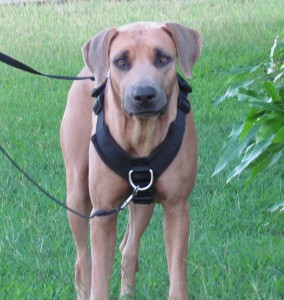
First time Jaime wore a Perfect Fit Harness.
I had the opportunity to try out Sally Hopkins’ Perfect Fit Harness and I really like it. Here are my first impressions:
Vibrant Colours
I just love the wide range of colours that the top piece comes in. My favourite is the purple, but they have so many rich, vibrant colours to choose from – black, blue, brown, green, pink, purple, red, blue, wine, black reflective, high vis yellow, high vis orange and black fleece with rainbow webbing. The front and girth pieces are only available in black webbing and fleece.
Soft Yet Strong
The fleece is just so soft and comfortable that it makes me want to just rest it against my face. But even though the fleece is soft, it is very strong and durable. The fleece reduces rubbing and pressure points. The nylon webbing is strong too.
Adaptable Sizing
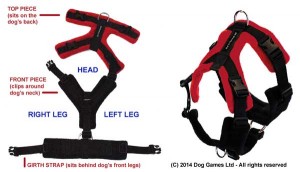
Perfect Fit Harness pieces
The Perfect Fit Harness comes in three pieces. The front is Y shaped and goes around the dog’s neck with the tail piece of the Y going between the dog’s front legs. It has black webbing stitched on to black fleece with the D-ring front attachment. The top piece has the webbing stitched on to the coloured fleece along with a D-ring attachment at the back. The girth piece also has black webbing where the D-ring is reinforced. This D-ring on the girth piece is where the tail end of the Y-front piece is attached.
Having three individual pieces – front, top and girth piece – is great because as your puppy grows, or if it is damaged, you just buy the piece(s) that you need instead of buying a whole harness.
Sturdy & Well Made
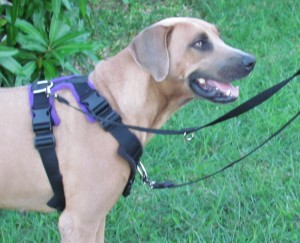
Jaime posing in the Perfect Fit Harness
This harness is extremely well made – the stitching is neat, the three metal D-rings are smooth and strong, and the plastic adjustable clips are sturdy.
Sizes
There is a wide range of sizes to choose from. It ranges in size from tiny, which could fit a 4 month old Chihuahua or cats, to extra large, which is made for huge Mastiffs or even large pigs. The girth and front pieces have five points of adjustment to make the front and girth pieces smaller or larger. The D-rings and clips come in a variety of sizes too from small 15mm to extra large 40mm.
Easy to put on
Phew, what a relief! Harnesses come in different styles and are for the most part a pain to figure out how to put on. I found the Perfect Fit Harness to be easy. Attach the front and top pieces together, attach the girth to the front, put the back and front piece over your dog’s head, slip the girth piece under your dog’s chest, between his leg and then just clip the snaps of girth to the top piece. Voila!
How it works
You need a double ended clip leash to attach to the front and top D rings, to help with steering. I also found it easy to control the dog and it helps prevent pulling. You should not have the leash tight at both ends.
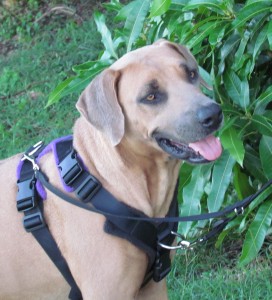
Jaime got used to the Perfect Fit Harness quickly and easily.
Tripods
An added bonus to this harness is that it can be adjusted and used for dogs who have had a front leg amputated. There is a video on the website to see how to choose.
Website
The Perfect Fit Harness website is full of useful information from the colour choices, sizing, and a Breed Chart Guideline with lots of videos too.
http://www.dog-games-shop.co.uk/perfect-fit-fleece-dog-harness.html
I have to admit, this is my new favourite harness!
 Molly Sumridge runs Kindred Companions in Frenchtown, NJ. We discussed all of the information available to members. Animal shelter volunteers can receive a discount. The IAABC library contains a tremendous amount of reading and handout materials in addition to access to world-renown animal behavior experts. We also discuss how Molly juggles the challenges and benefits of having a business that involves dog training, pet sitting, and a physical pet store.
Molly Sumridge runs Kindred Companions in Frenchtown, NJ. We discussed all of the information available to members. Animal shelter volunteers can receive a discount. The IAABC library contains a tremendous amount of reading and handout materials in addition to access to world-renown animal behavior experts. We also discuss how Molly juggles the challenges and benefits of having a business that involves dog training, pet sitting, and a physical pet store.



 While most of the speakers at the Canine Science Symposium are former or current students of Clive Wynne (the director of the Canine Science Collboratory), our research interests are diverse as evidenced by this year’s Symposium topics. Our presentations include decoding dominance in dogs; canine sociability and attachment; using advanced behavioral principles in dog training; applying cognitive, behavioral and physiological measures to improve shelter dog welfare; using play as training and enrichment; understanding visitor behavior in shelters to increase adoptions; exploring canine olfaction and interpreting canine body language. We want those that come out to learn with us to be able to walk away with new techniques and approaches to try in their interactions with shelter dogs, dogs that they train and the dogs they live with.
While most of the speakers at the Canine Science Symposium are former or current students of Clive Wynne (the director of the Canine Science Collboratory), our research interests are diverse as evidenced by this year’s Symposium topics. Our presentations include decoding dominance in dogs; canine sociability and attachment; using advanced behavioral principles in dog training; applying cognitive, behavioral and physiological measures to improve shelter dog welfare; using play as training and enrichment; understanding visitor behavior in shelters to increase adoptions; exploring canine olfaction and interpreting canine body language. We want those that come out to learn with us to be able to walk away with new techniques and approaches to try in their interactions with shelter dogs, dogs that they train and the dogs they live with.










